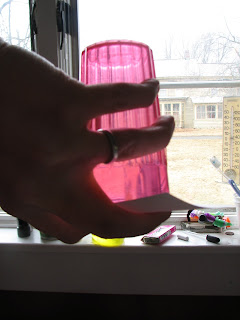I created this activity when my earth science class (6th grade) was in a bit of an activity drought. It's not an experiment, but it does practice measurement (an important science skill) and breaks the monotony of textbook reading and note-taking.
I billed it as a lesson in direction following....
Each student will need a 30 cm (about 12 inches... you're probably looking at construction paper) strip of paper, any width appropriate for a bookmark.
They will be creating a bookmark that illustrates a core sample of the whole earth (i.e. where the layers would occur if one were to drill a hole all the way through the earth).
In the textbook my students used, the layers of the earth were presented in two ways: the compositional layers (as seen above; the crust, mantle, and core) and the layers based on physical properties (lithosphere, asthenosphere, mesosphere, outer core and inner core).
I have create instructions for each "set" of layers. Here they are:
The Layers of the Earth, by Composition
1. You will be given a strip of paper 30 cm long.
2. Measure 1/2 (.5) cm from the top of the paper and draw a line.
3. Label this section "Crust".
4. Measure 7 cm from the previous line and draw a line.
5. Label this section "Mantle".
6. Measure 15 cm from the previous line and draw a line.
7. Label this section "Core".
8. Measure 7 cm from the previous line and draw a line.
9. Label this section "Mantle".
10. There should be 1/2 (.5) cm remaining at the end of the paper, label this section "Crust".
11. Color the two sections labeled Crust the same color.
12. Choose a second color and use it to color the two sections labeled Mantle.
13. Choose a third color and use it to color the section labeled Core.
The Layers of the Earth, by Physical Properties
1. You will be given a strip of paper 30 cm long.
2. Measure 1/2 (.5) cm from the top of the paper and draw a line.
3. Label this section "Lithosphere".
4. Measure 1/2 (.5) cm from the previous line and draw a line.
5. Label this section "Asthenosphere".
6. Measure 6-1/2 (6.5) cm from the previous line and draw a line.
7. Label this section "Mesosphere".
8. Measure 6 cm from the previous line and draw a line.
9. Label this section "Outer Core".
10. Measure 3 cm from the previous line and draw a line.
11. Label this section "Inner Core".
12. Measure 6 cm from the previous line and draw a line.
13. Label this section "Outer Core".
14. Measure 6-1/2 (6.5) cm from the previous line and draw a line.
15. Label this section "Mesosphere".
16. Measure 1/2 (.5) cm from the previous line and draw a line.
17. Label this section "Asthenosphere".
18. There should be 1/2 (.5) cm of space left at the end of the paper, label this space "Lithosphere".
19. Color the two sections labeled Lithosphere the same color.
20. Choose another color and use it to color the two sections labeled Asthenosphere.
21. Choose a third color and use it to color the two sections labeled Mesosphere.
22. Choose a fourth color and use it to color the two sections labeled Outer Core.
23. Choose a fifth color and use it to color the section labeled Inner Core.
In the past, I've had my students put one division of layers on each side of the bookmark. My latest idea has been to cut the papers twice as wide and have the students fold the paper in half.

Then, students can open up their bookmark and compare the two systems. You'll notice that the crust and lithosphere are comparable. The mantle is made of the asthenosphere and mesosphere. And the outer core and inner core should line up with the section simply labeled "core".



















































